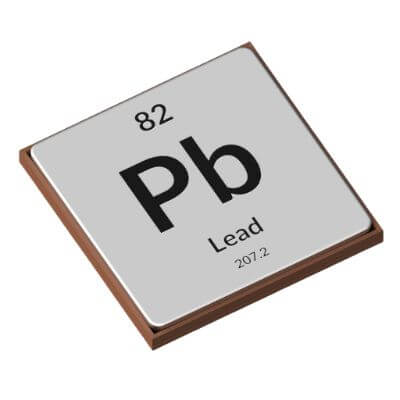
- Name: Lead
- Symbol: Pb
- Atomic Number: 83
- Atomic Weight: 207.2 u
- Period: 6
- Group: 14 (carbon group)
32 Lead Facts for Kids
- Lead is a chemical element on the periodic table.
- Lead is a metal that is soft and malleable.
- Lead in its pure form has a metallic gray color, but when freshly cut it can have a slight hint of blue.
- Lead was first discovered in the Middle East (Asia Minor) between 7,000 and 6,500 BCE based on metallic lead beads discovered by archeologists. These metallic lead beads also represent some of the first examples of metal smelting.
- The symbol for lead is Pb.
- The atomic number for lead is 82.
- The standard atomic weight of lead is 207.2 u.
- Lead is a solid at room temperature.
- Lead is in the post-transition metal element category on the periodic table.
- Lead is a period 6 chemical element, which is the sixth row on the periodic table.
- Lead is a group 14 chemical element, which is the carbon group.
- Lead is in the p-block on the periodic table.
- The electron configuration for lead is [Xe] 4f14 5d10 6s2 6p2.
- The electrons per shell for lead are 2, 8, 18, 32, 18, 4.
- Lead has four stable isotopes.
- The four stable isotopes for lead are 204Pb, 206Pb, 207Pb and 208Pb.
- The melting point for lead is 621.43 °F (327.46 °C).
- The boiling point for lead is 3180 °F (1749 °C).
- Lead is the 38th most abundant element found in the Earth’s crust.
- In our Solar System lead is found in 10 ppb (parts per billion) in weight.
- The most important ore of lead is galena (PbS), lead is also found in ores of copper, silver and zinc.
- According to the USGA, the worldwide proven reserves of lead in 2018 was 992 million tons.
- According to the USGA, the world produced around 4.9 million tons of lead in 2018.
- According to the USGA, the world’s largest producer of lead in 2018 was China with around 2.3 million tons.
- Based on USGA data, China produced over 46% of the world’s supply of lead in 2018.
- One of the most popular uses of lead in the 21st century is lead-acid batteries that are used in cars.
- Leads light weight and malleable properties make it an excellent architectural metal. Lead is used for cladding, flashing, gutters and roofing materials.
- Lead and lead alloys are the primary material for the projectile part of a bullet.
- The corrosion resistant properties of lead make it a great protective sheath for cables ran underwater.
- You know that wooden pencil that you think contains lead? Guess what, it doesn’t, it contains graphite.
- Lead is very poisonous to humans and when inhaled or swallowed it will affect every part of the human body.
- The Flint water crisis is the most notorious case of lead in drinking water. Flint, a city in Michigan didn’t apply corrosion inhibitors to the water they sourced from the Flint River. This allowed lead from aging pipes to leach into the water supply and expose more than 100,000 residents to high levels of lead.
Additional Resources on Lead
- Lead (Pb) – Learn more about the chemical element lead on the Los Alamos National Laboratory website.
- Facts About Lead – Find more facts about the chemical element lead on the Live Science website.
- Lead Health Problems – Learn about all the negative affects lead can have on your health on the CDC website.
- Lead – Wikipedia – Discover more lead facts, information and uses on the Wikipedia website.
